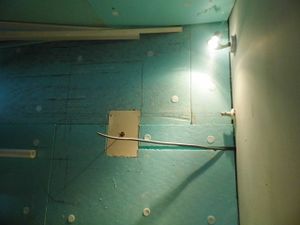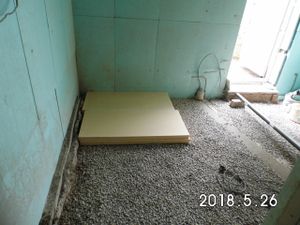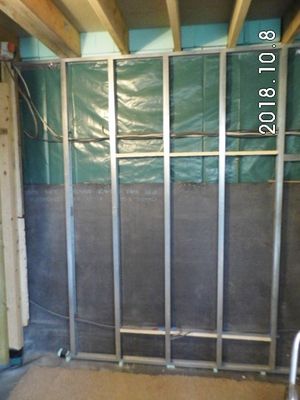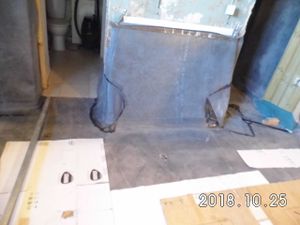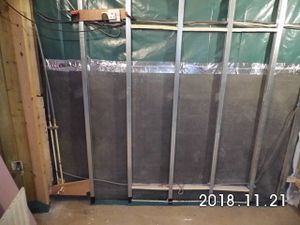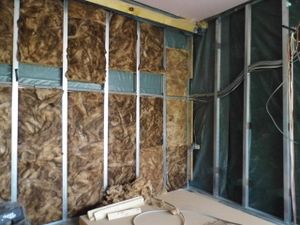Difference between revisions of "Stone Wall Double Internal Insulation"
m (style improvement) |
(final clean-up) |
||
| Line 20: | Line 20: | ||
==== Materials ==== | ==== Materials ==== | ||
| + | Most of the materials I used were not normal stock. I had to research and order especially. But the costs weren't prohibitive, in fact quite reasonablly priced. | ||
| + | |||
I had used both EPDM and XPS some years before, on an inverted flat roof project, which is how I came to know their properties. That gave me confidence in using both in a new way. XPS is not as insulating as the popular PIR, 80mm of XPS is as good as 60mm of PIR.([[Insulation|see insulation list)]]. But it's stronger and the sheets don't warp, split or buckle. XPS is tough stuff! Easy to saw too. No dust, no mask needed.[[File:DSCI0404.JPG|thumb|Door entrances formed in EPDM]] | I had used both EPDM and XPS some years before, on an inverted flat roof project, which is how I came to know their properties. That gave me confidence in using both in a new way. XPS is not as insulating as the popular PIR, 80mm of XPS is as good as 60mm of PIR.([[Insulation|see insulation list)]]. But it's stronger and the sheets don't warp, split or buckle. XPS is tough stuff! Easy to saw too. No dust, no mask needed.[[File:DSCI0404.JPG|thumb|Door entrances formed in EPDM]] | ||
The inside render was hard sand and cement so would easily support the Kingspan Styrozone N300R I chose for my middle lining. This came in 600 x 1250 rebated sheets. I discovered "insulation supports" on the same supply web-site. These are 8mm nylon nails or spikes with a wide flat head and come in various lengths. I bought a box of 110mm spikes and nailed 80mm XPS onto the wall by drilling 8mm holes on a 300mm grid then hammering the spikes into the cement render. The XPS sheets fitted snugly with their overlapping edges. Fairly rigid, but enough bend to hug the bumps in the old wall. | The inside render was hard sand and cement so would easily support the Kingspan Styrozone N300R I chose for my middle lining. This came in 600 x 1250 rebated sheets. I discovered "insulation supports" on the same supply web-site. These are 8mm nylon nails or spikes with a wide flat head and come in various lengths. I bought a box of 110mm spikes and nailed 80mm XPS onto the wall by drilling 8mm holes on a 300mm grid then hammering the spikes into the cement render. The XPS sheets fitted snugly with their overlapping edges. Fairly rigid, but enough bend to hug the bumps in the old wall. | ||
| Line 27: | Line 29: | ||
Available approved tanking materials seem archaic to me and difficult to DIY. I needed a DPM between the floor XPS and the screed above it, this had to run more than a metre up the walls to meet the underground room tanking rules, so I put this between the XPS middle lining and the metal inner studs. I decided to use Firestone EPDM rubber as it does not interact with either XPS or screed and can stretch 300%. It comes in widths up to 4.5m and any length, folded in a box. The room was small enough so I could tank it with a single sheet, dog-ear fold the corners and stuff them behind the stud and hang the edges up on thin plywood strips between the studs. I folded the rubber over these strips and stapled generously. I had to cut out two door entrances and form them with offcuts which I glued to the main sheet with the special weld solvent and adhesive specific to EPDM. | Available approved tanking materials seem archaic to me and difficult to DIY. I needed a DPM between the floor XPS and the screed above it, this had to run more than a metre up the walls to meet the underground room tanking rules, so I put this between the XPS middle lining and the metal inner studs. I decided to use Firestone EPDM rubber as it does not interact with either XPS or screed and can stretch 300%. It comes in widths up to 4.5m and any length, folded in a box. The room was small enough so I could tank it with a single sheet, dog-ear fold the corners and stuff them behind the stud and hang the edges up on thin plywood strips between the studs. I folded the rubber over these strips and stapled generously. I had to cut out two door entrances and form them with offcuts which I glued to the main sheet with the special weld solvent and adhesive specific to EPDM. | ||
| − | Strangely, the manufacturer's team couldn't show a BBA certificate for this construction method. They have approval for swimming pools, roofs, or whole-house wrapping where the EPDM is outside a new-build. The only explanation | + | Strangely, the manufacturer's team couldn't show a BBA certificate for this construction method. They have approval for swimming pools, roofs, or whole-house wrapping where the EPDM is outside a new-build. The only explanation they could give me was that much solvent weld/glue use is expected to join sheets so EPDM cannot be used indoors for health reasons. My tiny room needed only a single sheet and a little glue so I wore a mask and kept the doors open. I'm at home, not at work, so the H&S acts don't apply. |
[[File:DSCI0416.JPG|thumb|Floor screed embeds wall channel.]] | [[File:DSCI0416.JPG|thumb|Floor screed embeds wall channel.]] | ||
| Line 33: | Line 35: | ||
After spiking the XPS to the wall (top picture), I used a router to carve a rebate for a plywood support panel which I anchored through into the wall. I also routed a pipe channel to it. This is in a side-room toilet/shower where the inner lining is plastic 10mm cladding and not metal stud. The decorative panels are stuck to the XPS with a grip-fill adhesive. The 80mm XPS wall panels are blue (2nd picture) and the 100mm floor panels are cream. The 100mm floor panels were stamped into the gravel and grit until they didn't spring back, a little bit of packing adjustment was needed, not much. After the EPDM was laid, I spent some days walking on it (you can see protective beige carpet scraps) but it didn't try to shift or bulge. Ultimately the weight of the screed holds it down. | After spiking the XPS to the wall (top picture), I used a router to carve a rebate for a plywood support panel which I anchored through into the wall. I also routed a pipe channel to it. This is in a side-room toilet/shower where the inner lining is plastic 10mm cladding and not metal stud. The decorative panels are stuck to the XPS with a grip-fill adhesive. The 80mm XPS wall panels are blue (2nd picture) and the 100mm floor panels are cream. The 100mm floor panels were stamped into the gravel and grit until they didn't spring back, a little bit of packing adjustment was needed, not much. After the EPDM was laid, I spent some days walking on it (you can see protective beige carpet scraps) but it didn't try to shift or bulge. Ultimately the weight of the screed holds it down. | ||
| − | The EPDM was hung over half way up the wall (3rd picture) to sit well above ground level at the highest point on the hill slope. The bottom stud channel is sitting on 50mm XPS offcuts and the sharp ends are buffered with scraps and tape, well away from the EPDM. (ignore the carpet in front). The edge | + | The EPDM was hung over half way up the wall (3rd picture) to sit well above ground level at the highest point on the hill slope. The bottom stud channel is sitting on 50mm XPS offcuts and the sharp ends are buffered with scraps and tape, well away from the EPDM. (ignore the carpet in front). The upper edge hangers are hidden behind the air control polythene. |
| − | Two doorway entrances needed to be cut in the EPDM and scraps used to seal the corners (4th picture - ignore the carpet and cardboard protectors). The screed ensures the joins won't unpeel. Here | + | Two doorway entrances needed to be cut in the EPDM and scraps used to seal the corners (4th picture - ignore the carpet and cardboard protectors). The screed ensures the joins won't unpeel. Here, the top of the EPDM is battened to an internal partition wall which isn't insulated. |
[[File:DSCI0306.JPG|thumb|Stud infilled with services]] | [[File:DSCI0306.JPG|thumb|Stud infilled with services]] | ||
| Line 43: | Line 45: | ||
==== Conclusion ==== | ==== Conclusion ==== | ||
| − | Three years on, not one problem arisen. | + | Three years on, not one problem arisen. I'm cosy and warm in here. My daily running costs rise from under £1 in Summer to just over £3 in a cold snap, and my energy supplier has me on £55 a month debit. |
| + | |||
| + | I'm glad I didn't go for the cavity wall or the timber frame solutions. As the need for insulation increases, building two walls isn't going to hack it, you're going to need triple walls. The building industry isn't going to like that, but for DIY it's just extra time and I've got plenty of that. | ||
| − | |||
[[Category:Walls]] | [[Category:Walls]] | ||
[[Category:Projects]] | [[Category:Projects]] | ||
[[Category:Insulation]] | [[Category:Insulation]] | ||
Latest revision as of 18:39, 6 November 2021
A double dry-lining project in a stone cottage
This was a refurbishment of an old cottage built with thick random stone walls and a flagstone floor. The rear extension, the old scullery and outside toilet, were modernised to fit a study above and a kitchen below. On a steep hill, the lower half half of the kitchen walls were below ground level.
The inside of the stonework had been cement rendered and whitewashed decades ago, It had crazed cracks, rusty hooks, lumps and bumps, and no damp proof course or tanking membrane. The flagstone floor was uneven and cracked too. Outside the paintwork was cracked in places and flaking off the mortar between the stones,.
Planning
Advice from builders and council building control was the usual mantras going back to tried and tested methods from the 1950's. Ignoring that, I approached it from an engineering viewpoint, I submitted the design that follows and the response was that it was "not an approved system" so I would have to get it reviewed and approved by an architect. Ignoring that too, I fired the building control service and went ahead anyway. I'm not selling up in my lifetime, and it will deter the asset-strippers after I'm gone that no regularisation will be possible without a lot of pain. The new walls are fine after 3 years of my occupation here, I have no worry about the success of my project so far.
Design
A cavity wall would mean building an inner leaf. but there was only sandy clay under the floor flagstones. I briefly considered timber frame, but the boards would be very wide meaning more expense and less stability. Seems that timber frame has reached the end of its feasibility nowadays. I couldn't get a decent U-value with just one lining so I went for a double-lining. I could then use two different methods giving something like a filled cavity wall. I reasoned that it didn't matter if the old outer wall was waterproof or not as long as the water went out the same way it came in and didn't enter the dwelling. That removed the need for better exterior rendering, saving money there. But I needed waterproofing and a tanking membrane inside as the wall was part underground. So for my first skin I chose XPS which does both insulation and waterproofing in one. For the second, inner lining I chose mineral fibre between steel stud. Neither are affected by moisture and the middle XPS means the dew point will never reach the inner wall. Easy to run services inside that and I could dispense with the usual vapour barrier under the plasterboard, allowing moist air to return to the room through the board.. I submitted this specification to the free service provided by Kingspan, as I was using their XPS product, and their calculation gave a U-value for the walls of 0.19W/m2K which was way ahead of the current requirement at that time.
I lifted the floor flagstones and relegated them to the garden path. I dug out 300mm of sandy clay and laid 100mm of drainage gravel, clean chips without silt. The gravel is clean so any water that did manage to drain down the outside of the DPM would soak away through this layer into the sandy base and away down the hill. Over that I dropped a thin layer of grit and layed 100mm sheets of XPS. Did a bit of dancing on it until it settled, added a membrane (see later) and had 70mm of ready-mixed fibre-rich special flooring screed spread on top, which I later tiled.
The membrane edges I ran up the inside of the wall's central XPS lining before I built the inner metal studwork. Then I built the stud wall between an upper U-channel fixed to the ceiling joist and a lower U-channel raised on 50mm blocks on the floor XPS. The floor screed locked the lower channel and the top of it was the level guide for the screeding float. so the channel is now embedded in the floor.
The edges of the damp-proof-membrane were now trapped between the two wall linings, not very securely, so I battened the edges and hung them from the inside of the metal studs with wire so they can't slip down or fold.
Materials
Most of the materials I used were not normal stock. I had to research and order especially. But the costs weren't prohibitive, in fact quite reasonablly priced.
I had used both EPDM and XPS some years before, on an inverted flat roof project, which is how I came to know their properties. That gave me confidence in using both in a new way. XPS is not as insulating as the popular PIR, 80mm of XPS is as good as 60mm of PIR.(see insulation list). But it's stronger and the sheets don't warp, split or buckle. XPS is tough stuff! Easy to saw too. No dust, no mask needed.
The inside render was hard sand and cement so would easily support the Kingspan Styrozone N300R I chose for my middle lining. This came in 600 x 1250 rebated sheets. I discovered "insulation supports" on the same supply web-site. These are 8mm nylon nails or spikes with a wide flat head and come in various lengths. I bought a box of 110mm spikes and nailed 80mm XPS onto the wall by drilling 8mm holes on a 300mm grid then hammering the spikes into the cement render. The XPS sheets fitted snugly with their overlapping edges. Fairly rigid, but enough bend to hug the bumps in the old wall.
The fronting lining I chose 50mm metal I-stud which is stronger than the usual C-stud, Doesn't corrode, has service slots punched htrough for pipes and cables, and I could bed it into the floor screed yet still slide the studs along the channel. I filled the inner lining with 50mm rockwool cavity batts after all the services were in place, cutting the batts to size with cloth shears. I screwed 12mm fireline plasterboard to the studs with dry-wall black screws. Without a jig, this was hard work, so I pre-drilled 2,5mm which helped.
Available approved tanking materials seem archaic to me and difficult to DIY. I needed a DPM between the floor XPS and the screed above it, this had to run more than a metre up the walls to meet the underground room tanking rules, so I put this between the XPS middle lining and the metal inner studs. I decided to use Firestone EPDM rubber as it does not interact with either XPS or screed and can stretch 300%. It comes in widths up to 4.5m and any length, folded in a box. The room was small enough so I could tank it with a single sheet, dog-ear fold the corners and stuff them behind the stud and hang the edges up on thin plywood strips between the studs. I folded the rubber over these strips and stapled generously. I had to cut out two door entrances and form them with offcuts which I glued to the main sheet with the special weld solvent and adhesive specific to EPDM.
Strangely, the manufacturer's team couldn't show a BBA certificate for this construction method. They have approval for swimming pools, roofs, or whole-house wrapping where the EPDM is outside a new-build. The only explanation they could give me was that much solvent weld/glue use is expected to join sheets so EPDM cannot be used indoors for health reasons. My tiny room needed only a single sheet and a little glue so I wore a mask and kept the doors open. I'm at home, not at work, so the H&S acts don't apply.
Construction details
After spiking the XPS to the wall (top picture), I used a router to carve a rebate for a plywood support panel which I anchored through into the wall. I also routed a pipe channel to it. This is in a side-room toilet/shower where the inner lining is plastic 10mm cladding and not metal stud. The decorative panels are stuck to the XPS with a grip-fill adhesive. The 80mm XPS wall panels are blue (2nd picture) and the 100mm floor panels are cream. The 100mm floor panels were stamped into the gravel and grit until they didn't spring back, a little bit of packing adjustment was needed, not much. After the EPDM was laid, I spent some days walking on it (you can see protective beige carpet scraps) but it didn't try to shift or bulge. Ultimately the weight of the screed holds it down.
The EPDM was hung over half way up the wall (3rd picture) to sit well above ground level at the highest point on the hill slope. The bottom stud channel is sitting on 50mm XPS offcuts and the sharp ends are buffered with scraps and tape, well away from the EPDM. (ignore the carpet in front). The upper edge hangers are hidden behind the air control polythene.
Two doorway entrances needed to be cut in the EPDM and scraps used to seal the corners (4th picture - ignore the carpet and cardboard protectors). The screed ensures the joins won't unpeel. Here, the top of the EPDM is battened to an internal partition wall which isn't insulated.
Next the screed has buried the bottom channel (5th picture). The blue strip visible is a thin barrier to stop the channel filling with screed. The aluminium tape closes the poly air barrier to the EPDM.
Finally the stud is in-filled with mineral fibre (6th picture). This is the upper floor, here the bottom channel is screwed down to the chipboard flooring. One of the main roof purlins is visible just below the ceiling.
Conclusion
Three years on, not one problem arisen. I'm cosy and warm in here. My daily running costs rise from under £1 in Summer to just over £3 in a cold snap, and my energy supplier has me on £55 a month debit.
I'm glad I didn't go for the cavity wall or the timber frame solutions. As the need for insulation increases, building two walls isn't going to hack it, you're going to need triple walls. The building industry isn't going to like that, but for DIY it's just extra time and I've got plenty of that.
